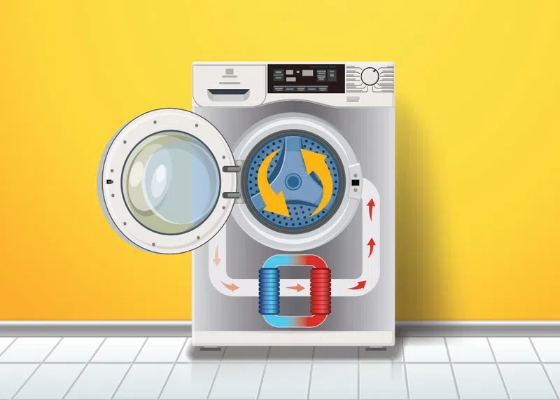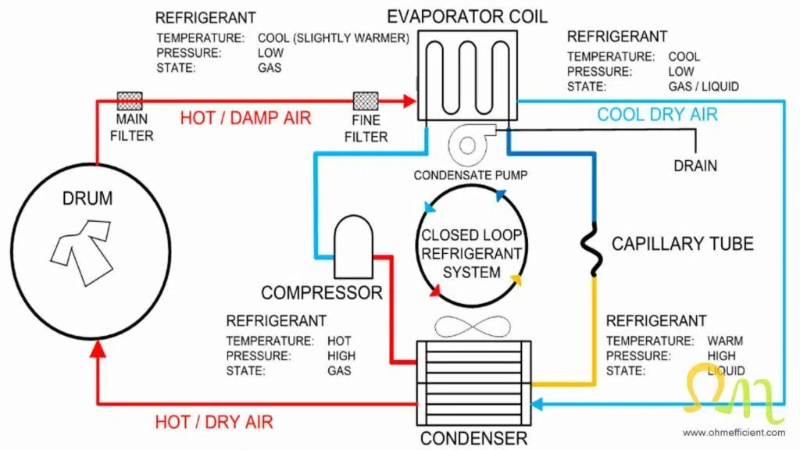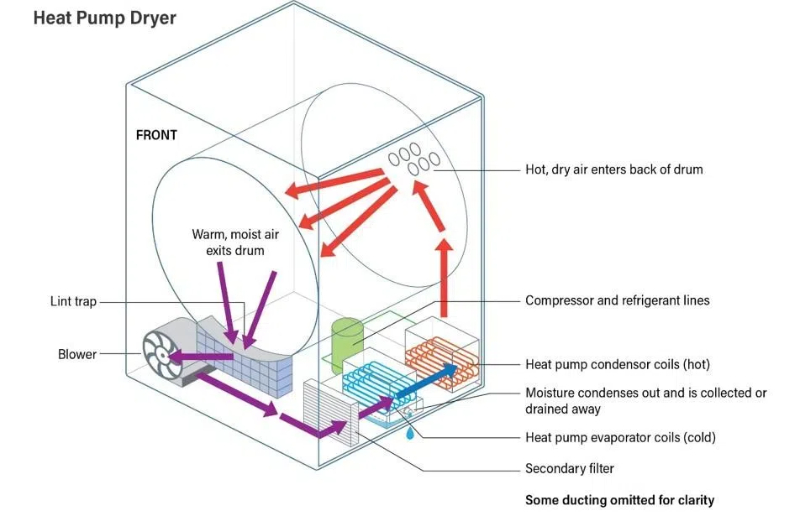
Content Menu
● Introduction
● How Heat Pump Clothes Dryers Work
● Advantages of Heat Pump Dryers
>> Energy Efficiency
>> Gentle on Clothes
>> No Need for Venting
>> Eco-Friendly Operation
● Energy Savings and Cost-Effectiveness
● Maintenance and Care
● Choosing the Right Heat Pump Dryer
● The Future of Laundry Technology
● Conclusion
● Frequently Asked Questions
>> 1. How much energy can I save with a heat pump dryer?
>> 2. Are heat pump dryers more expensive than traditional dryers?
>> 3. Do heat pump dryers take longer to dry clothes?
>> 4. Can heat pump dryers be installed anywhere in the home?
>> 5. How often do I need to maintain a heat pump dryer?
Introduction
In recent years, the laundry industry has seen a significant technological advancement with the introduction of heat pump clothes dryers. These innovative appliances are revolutionizing the way we dry our clothes, offering a more energy-efficient and eco-friendly alternative to traditional dryers. As consumers become increasingly conscious of their energy consumption and environmental impact, heat pump dryers are gaining popularity in households worldwide.
How Heat Pump Clothes Dryers Work
Heat pump dryers operate on a fundamentally different principle compared to conventional dryers. Instead of continuously heating air and venting it outside, these appliances use a closed-loop system that recycles and reuses hot air to dry clothes efficiently.
The process begins when warm, dry air is fed into the drum containing wet clothes. As the drum rotates, moisture from the clothes is absorbed into the air. This warm, moist air then passes over an evaporator coil filled with cold refrigerant. The cold refrigerant absorbs heat from the air, causing the moisture to condense into water, which is collected in a tank or drained away.
The now-cooled air passes through a compressor, which heats it up again. This reheated air is then circulated back into the drum to continue the drying process. This closed-loop system allows heat pump dryers to operate at lower temperatures than conventional dryers, which is gentler on clothes and more energy-efficient.

Advantages of Heat Pump Dryers
Energy Efficiency
One of the most significant advantages of heat pump dryers is their exceptional energy efficiency. By recycling hot air and operating at lower temperatures, these appliances can achieve energy savings of up to 50% compared to conventional dryers. This reduction in energy consumption not only helps lower utility bills but also contributes to a more sustainable environment by reducing greenhouse gas emissions.
Gentle on Clothes
The lower operating temperatures of heat pump dryers are much gentler on fabrics. This means less wear and tear on your clothes, helping them last longer and maintain their quality. Delicate items that might be damaged by high heat in conventional dryers can often be safely dried in a heat pump dryer.
No Need for Venting
Unlike traditional vented dryers, heat pump dryers do not require an external vent. This makes them more flexible in terms of installation, as they can be placed in various locations within the home. It also eliminates the need for duct cleaning and maintenance associated with vented systems.
Eco-Friendly Operation
By significantly reducing energy consumption, heat pump dryers help decrease the carbon footprint of household laundry. If all new electric dryers sold in the U.S. were ENERGY STAR certified heat pump dryers, they could potentially reduce emissions equivalent to taking 152,000 vehicles off the road.
Energy Savings and Cost-Effectiveness
While heat pump dryers typically have a higher upfront cost compared to conventional dryers, the long-term savings on energy bills can make them a cost-effective choice for many households. The exact savings will depend on factors such as local energy prices, frequency of use, and the specific model of the dryer.
For example, ENERGY STAR certified heat pump dryers can use up to 60% less energy than standard models. Over the lifetime of the appliance, this can translate to significant savings on electricity costs. Additionally, some regions offer rebates or incentives for purchasing energy-efficient appliances, which can help offset the initial investment.

Maintenance and Care
Proper maintenance is crucial for ensuring the longevity and optimal performance of a heat pump dryer. Here are some key maintenance tips:
1. Clean the lint filter after every use to maintain airflow and efficiency.
2. Regularly empty the water collection tank if your model doesn't have a direct drain option.
3. Clean the heat exchanger (condenser) periodically to remove any lint buildup.
4. Check and clean the moisture sensors to ensure accurate drying cycles.
5. Keep the area around the dryer well-ventilated to allow for proper air circulation.
Choosing the Right Heat Pump Dryer
When selecting a heat pump dryer, consider the following factors:
1. Capacity: Ensure the dryer's capacity matches your household's needs.
2. Energy rating: Look for models with high energy efficiency ratings.
3. Features: Consider additional features like smart connectivity, multiple drying programs, and noise reduction technology.
4. Size and installation requirements: Measure your space and check if the model fits your laundry area.
5. Brand reputation and warranty: Choose reputable brands with good customer support and warranty coverage.
The Future of Laundry Technology
As technology continues to advance, we can expect further improvements in heat pump dryer efficiency and functionality. Some potential developments include:
1. Integration with smart home systems for optimized energy use.
2. Improved sensors for more precise moisture detection and drying cycles.
3. Enhanced eco-friendly materials and manufacturing processes.
4. Combination units that incorporate both washing and heat pump drying functions.
Conclusion
Heat pump clothes dryers represent a significant step forward in laundry technology, offering substantial energy savings, gentler fabric care, and reduced environmental impact. While they may require a higher initial investment, the long-term benefits in terms of energy efficiency and clothes preservation make them an attractive option for environmentally conscious consumers and those looking to reduce their energy bills.
As we move towards a more sustainable future, technologies like heat pump dryers play a crucial role in reducing household energy consumption and minimizing our carbon footprint. By choosing energy-efficient appliances, we can all contribute to a greener planet while enjoying the benefits of advanced laundry care.

Frequently Asked Questions
1. How much energy can I save with a heat pump dryer?
Heat pump dryers can save up to 50-60% of energy compared to conventional dryers. The exact savings depend on usage patterns and local energy prices, but many users report significant reductions in their electricity bills.
2. Are heat pump dryers more expensive than traditional dryers?
Yes, heat pump dryers typically have a higher upfront cost. However, the energy savings over time can offset this initial investment, making them cost-effective in the long run.
3. Do heat pump dryers take longer to dry clothes?
Heat pump dryers generally take longer to dry clothes compared to conventional dryers due to their lower operating temperatures. However, the gentler drying process is better for your clothes and more energy-efficient.
4. Can heat pump dryers be installed anywhere in the home?
Since heat pump dryers don't require external venting, they offer more flexibility in terms of installation. They can be placed in various locations within the home, as long as there's adequate ventilation and space for the appliance.
5. How often do I need to maintain a heat pump dryer?
Regular maintenance includes cleaning the lint filter after each use, emptying the water tank (if applicable), and periodically cleaning the heat exchanger. It's also recommended to have the dryer professionally serviced every 1-2 years to ensure optimal performance.












